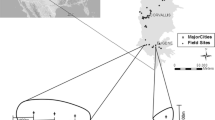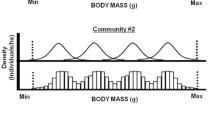Abstract
The use and applicability of the guild concept to management is evaluated and questioned. Ecological problems are never as simple as implied in using one or two guild axes. A close examination of bird communities in a ponderosa pine forest reveals little relationship between guilds or guild blocks and the responses exhibited by individual bird species or bird species groups. Response guilds changed from year to year without any obvious changes in vegetation. A three-year composite analysis shows a clearer picture of the responses of ponderosa pine forest birds to the overall interactions between structure, weather, competition, and so on. The six response groups in the composite analysis are species that (1) were absent in 1973 on most or all study plots and showed no preference for any forested site; (2) had their highest densities on the medium cut and light cut plots; (3) were absent in 1973 on most or all study plots and had their highest densities on the medium cut and light cut plots; (4) had their highest densities on the untreated, light cut, and medium cut plots; (5) had their highest densities on the untreated and light cut plots and were either absent or had greatly reduced densities on all other plots; and (6) were present only on the clearcut, except for the Rock Wren which was also on the medium cut and heavy cut plots. The overall correlation between species density and guild density was significantly higher for response guilds (α <0.05) than for any of the structural or functional guilds. The whole concept of guild management needs much more research and development before it can be recommended as a management tool.
Similar content being viewed by others
Literature cited
Brown, H. E., M. M. Baker, Jr., and J. J. Rogers. 1974. Opportunities for increasing water yields and other multiple use values on ponderosa pine forest lands. USDA Forest Service, Research Paper RM-129. Rocky Mountain Forest and Range Experiment Station, Fort Collins, Colorado, 36 pp.
Crome, F. H. H. 1978. Foraging ecology of an assemblage of birds in lowland rainforest in northern Queensland.Australian Journal of Ecology 3:195–212.
DeGraaf, R. M., and N. L. Chadwick. 1984. Habitat classification: a comparison using avian species and guilds.Environmental Management 8:511–518.
Engelman, L. 1981. Cluster analysis of cases. Pages 456–463in W. J. Dixon (chief ed.), BMDP statistical software 1981. University of California Press, Berkeley, California.
Folse, L. J., Jr. 1981. Ecological relationships of grassland birds to habitat and food supply in east Africa. Pages 160–166in D. E. Capen (ed.), The use of multivariate statistics in studies of wildlife habitat. USDA Forest Service, General Technical Report RM-87. Rocky Mountain Forest and Range Experiment Station, Fort Collins, Colorado.
Fretwell, S. D. 1972. Populations in a seasonal environment.Monographs in Population Biology 5:1–217.
Haefner, J. W. 1981. Avian community assembly rules: the foliage-gleaning guild.Oecologia 50:131–142.
Hind, T. 1985. Relationships between bird community and habitat structure in shelterbelts of Hokkaido, Japan.Oecologia 65:442–448.
Holmes, R. T., and S. K. Robinson. 1981. Tree species preferences of foraging insectivorous birds in a northern hardwood forest.Oecologia 48:31–35.
Holmes, R. T., R. E. Bonney, Jr., and S. W. Pacala. 1979. Guild structure of the Hubbard Brook bird community: a multivariate approach.Ecology 60:512–520.
Hutchinson, G. E. 1957. Concluding remarks. Cold Spring Harbor Symp.Quantitative Biology 22:415–427.
Jaksic, F. M. 1981. Abuse and misuse of the term “guild” in ecological studies.Oikos 37:397–400.
Johnson, R. A. 1981. Application of the guild concept to environmental impact analysis of terrestrial vegetation.Journal of Environmental Management 13:205–222.
Karr, J. R. 1976. Seasonality, resource availability, and community diversity in tropical bird communities.American Naturalist 110:973–994.
Karr, J. R. 1980. Geographical variation in the avifaunas of tropical forest undergrowth.Auk 97:283–298.
Kendeigh, S. C. 1944. Measurement of bird populations.Ecological Monographs 14:67–106.
Landres, P. B. 1973. Use of the guild concept in environmental impact assessment.Environmental Management 7:393–398.
Landres, P. B., and J. A. MacMahon. 1980. Guilds and community organization: analysis of an oak woodland avifauna in Sonora, Mexico.Auk 97:351–365.
MacMahon, J. A., D. J. Schimpf, D. C. Andersen, K. G. Smith, and R. L. Bayn, Jr. 1981. An organism-centered approach to some community and ecosystem concepts.Journal of Theoretical Biology 88:287–307.
Mannan, R. W., M. L. Morrison, and E. C. Meslow. 1984. The use of guilds in forest bird management.Wildlife Society Bulletin 12:426–430.
Patton, D. R. 1986. The concept and use of indicators in natural resource management.Western Journal of Applied Forestry (in press).
Pöysä, H. 1982. Resource utilization pattern and guild structure in a waterfowl community.Oikos 40:295–307.
Raphael, M. G. 1980. Utilization of standing dead trees by breeding birds at Sagehen Creek, California. PhD dissertation, University of California, Berkeley, California, 195 pp.
Rohlf, F. J. 1970. Adaptive hierarchical clustering schemes.Systematic Zoology 19:58–82.
Root, R. B. 1967. The niche exploitation pattern of the Bluegray Gnatcatcher.Ecological Monographs 37:317–350.
Rotenberry, J. T., R. E. Fitzner, and W. H. Richard. 1979. Seasonal variation in avian community structure: differences in mechanisms regulating diversity.Auk 96:499–505.
Severinghaus, W. D. 1981. Guild theory development as a mechanism for assessing environmental impact.Environmental Management 5:187–190.
Short, H. L. 1982. Development and use of a species richness model to evaluate wildlife habitat.Transactions of the North American Wildlife and Natural Resources Conference 47:57–72.
Short, H. L., and K. P. Burnham. 1982. Technique for structuring wildlife guilds to evaluate impacts on wildlife communities.USDI Fish and Wildlife Service, Special Scientific Report-Wildlife 244:1–33.
Szaro, R. C., and R. P. Balda. 1979a. Bird community dynamics in a ponderosa pine forest.Studies in Avian Biology 3:1–66.
Szaro, R. C., and R. P. Balda. 1979b. Effects of harvesting ponderosa pine on nongame bird populations. USDA Forest Service, Research Paper RM-212. Rocky Mountain Forest and Range Experiment Station, Fort Collins, Colorado, 8 pp.
Szaro, R. C., and R. P. Balda. 1986. Relationships among weather, habitat structure, and ponderosa pine forest birds.Journal of Wildlife Management 50:253–260.
Verner, J. 1984. The guild concept applied to management of bird populations.Environmental Management 8:1–14.
Whittaker, R. H. 1977. Evolution of species diversity in land communities.Evolutionary Biology 10:1–67.
Author information
Authors and Affiliations
Rights and permissions
About this article
Cite this article
Szaro, R.C. Guild management: an evaluation of avian guilds as a predictive tool. Environmental Management 10, 681–688 (1986). https://doi.org/10.1007/BF01866772
Issue Date:
DOI: https://doi.org/10.1007/BF01866772




